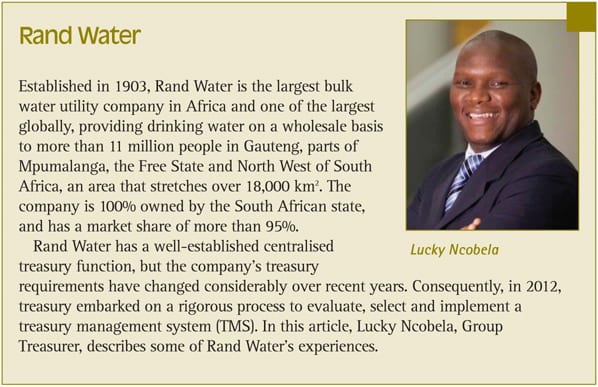by Lucky Ncobela, Group Treasurer, Rand Water

Changing treasury needs
In the past, as a cash-rich business, our treasury requirements were relatively straightforward and mainly involved cash investment. Major projects, such as the Lesotho Highlands Water Project (LHWP), the first phase of which was completed in 1998, and an ongoing investment programme to meet the needs of consumers in South Africa and maintain state-of-the-art infrastructure, have resulted in a distinct change in our treasury requirements, including:
- Cash management has become a greater priority, in particular ensuring complete, accurate and timely visibility of cash across the business;
- As debt levels have increased, financing transactions need to be recorded, managed and accounted for correctly, according to generally accepted accounting principles;
- Risk management, including both interest rate and FX risk have become priorities, necessitating sophisticated analysis and reporting tools;
- Compliance is also a key consideration, facilitating confidence and trust amongst both internal and external stakeholders.
Evaluation and selection
Before embarking on this project, treasury was managed using a database developed in-house and a series of spreadsheets. As our functional needs became more sophisticated, we recognised the need to upgrade our infrastructure and, as a state-owned business, to demonstrate industry best practices.
 We operate a formal process for procurement according to the PFMA (Public Finance Management Act, 1999) as required for state-owned businesses in South Africa. This necessitates a thorough due diligence process and objective decision criteria which can be very useful in developing a comprehensive selection framework. We issued an invitation to tender (ITT) but before sending the request for proposal (RFP) to tenderers, we reviewed and documented our IT architecture, short-term functional requirements and longer-term business strategy, including front office, middle office, back office, cash management, hedge accounting and most importantly, compliance and risk management. This ensured that we could determine the suitability of each solution and compare them consistently.
We operate a formal process for procurement according to the PFMA (Public Finance Management Act, 1999) as required for state-owned businesses in South Africa. This necessitates a thorough due diligence process and objective decision criteria which can be very useful in developing a comprehensive selection framework. We issued an invitation to tender (ITT) but before sending the request for proposal (RFP) to tenderers, we reviewed and documented our IT architecture, short-term functional requirements and longer-term business strategy, including front office, middle office, back office, cash management, hedge accounting and most importantly, compliance and risk management. This ensured that we could determine the suitability of each solution and compare them consistently.
Sign up for free to read the full article
Register Login with LinkedInAlready have an account?
Login
Download our Free Treasury App for mobile and tablet to read articles – no log in required.
Download Version Download Version




























